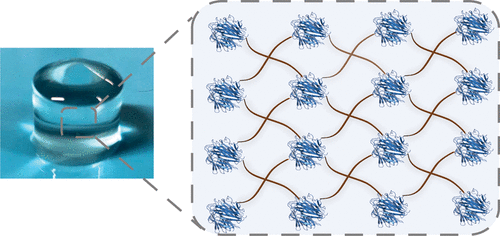当前位置:
X-MOL 学术
›
ACS Macro Lett.
›
论文详情
Our official English website, www.x-mol.net, welcomes your
feedback! (Note: you will need to create a separate account there.)
100th Anniversary of Macromolecular Science Viewpoint: Synthetic Protein Hydrogels
ACS Macro Letters ( IF 5.1 ) Pub Date : 2020-03-20 , DOI: 10.1021/acsmacrolett.0c00109 Ying Li 1 , Bin Xue 2 , Yi Cao 2, 3, 4
ACS Macro Letters ( IF 5.1 ) Pub Date : 2020-03-20 , DOI: 10.1021/acsmacrolett.0c00109 Ying Li 1 , Bin Xue 2 , Yi Cao 2, 3, 4
Affiliation

|
Our bodies are composed of soft tissues made of various proteins. In contrast, most hydrogels designed for biological applications are made of synthetic polymers. Recently, it is increasingly recognized that genetically synthesized proteins can be tailored as building blocks of hydrogels with biological, chemical, and mechanical properties similar to native soft tissues. In this Viewpoint, we summarize recent progress in synthetic protein hydrogels. We compare the structural and mechanical properties of different protein building blocks. We discuss various biocompatible cross-linking strategies based on covalent chemical reactions and noncovalent physical interactions. We introduce how stimulus-responsive conformational changes or intermolecular interactions at the molecular level can be used to engineer responsive hydrogels. We highlight that hydrogel network structures are as important as the protein sequences for the properties and functions of protein hydrogels and should be carefully designed. Despite great progress and potentials of synthetic protein hydrogels, there are still quite a few unsettled challenges and unexploited opportunities, providing abundant room for future investigation and development, particularly as this field is quickly expanding beyond its initial stage. We discuss a number of possible directions, including optimizing protein production and reducing cost, engineering anisotropic hydrogels to better mimic native tissues, rationally designing hydrogel mechanical properties, investigating interplays of hydrogels and residing cells for 3D cell culture and organoid construction, and evaluating long-term cytotoxicity and immune response.
中文翻译:

大分子科学观点一百周年:合成蛋白水凝胶
我们的身体由各种蛋白质组成的软组织组成。相比之下,大多数为生物应用设计的水凝胶都是由合成聚合物制成的。最近,人们越来越认识到,基因合成的蛋白质可以定制为具有类似于天然软组织的生物、化学和机械特性的水凝胶的构建块。在这个观点中,我们总结了合成蛋白质水凝胶的最新进展。我们比较了不同蛋白质构件的结构和机械性能。我们讨论了基于共价化学反应和非共价物理相互作用的各种生物相容性交联策略。我们介绍了如何使用分子水平的刺激响应构象变化或分子间相互作用来设计响应水凝胶。我们强调水凝胶网络结构对于蛋白质水凝胶的特性和功能与蛋白质序列一样重要,应该仔细设计。尽管合成蛋白质水凝胶取得了长足的进步和潜力,但仍然存在不少未解决的挑战和未开发的机遇,为未来的研究和发展提供了充足的空间,特别是在该领域正在迅速超越其初始阶段的情况下。我们讨论了许多可能的方向,包括优化蛋白质生产和降低成本、设计各向异性水凝胶以更好地模拟天然组织、合理设计水凝胶机械性能、研究水凝胶和驻留细胞的相互作用以进行 3D 细胞培养和类器官构建,以及评估长期术语细胞毒性和免疫反应。
更新日期:2020-04-23
中文翻译:

大分子科学观点一百周年:合成蛋白水凝胶
我们的身体由各种蛋白质组成的软组织组成。相比之下,大多数为生物应用设计的水凝胶都是由合成聚合物制成的。最近,人们越来越认识到,基因合成的蛋白质可以定制为具有类似于天然软组织的生物、化学和机械特性的水凝胶的构建块。在这个观点中,我们总结了合成蛋白质水凝胶的最新进展。我们比较了不同蛋白质构件的结构和机械性能。我们讨论了基于共价化学反应和非共价物理相互作用的各种生物相容性交联策略。我们介绍了如何使用分子水平的刺激响应构象变化或分子间相互作用来设计响应水凝胶。我们强调水凝胶网络结构对于蛋白质水凝胶的特性和功能与蛋白质序列一样重要,应该仔细设计。尽管合成蛋白质水凝胶取得了长足的进步和潜力,但仍然存在不少未解决的挑战和未开发的机遇,为未来的研究和发展提供了充足的空间,特别是在该领域正在迅速超越其初始阶段的情况下。我们讨论了许多可能的方向,包括优化蛋白质生产和降低成本、设计各向异性水凝胶以更好地模拟天然组织、合理设计水凝胶机械性能、研究水凝胶和驻留细胞的相互作用以进行 3D 细胞培养和类器官构建,以及评估长期术语细胞毒性和免疫反应。











































 京公网安备 11010802027423号
京公网安备 11010802027423号